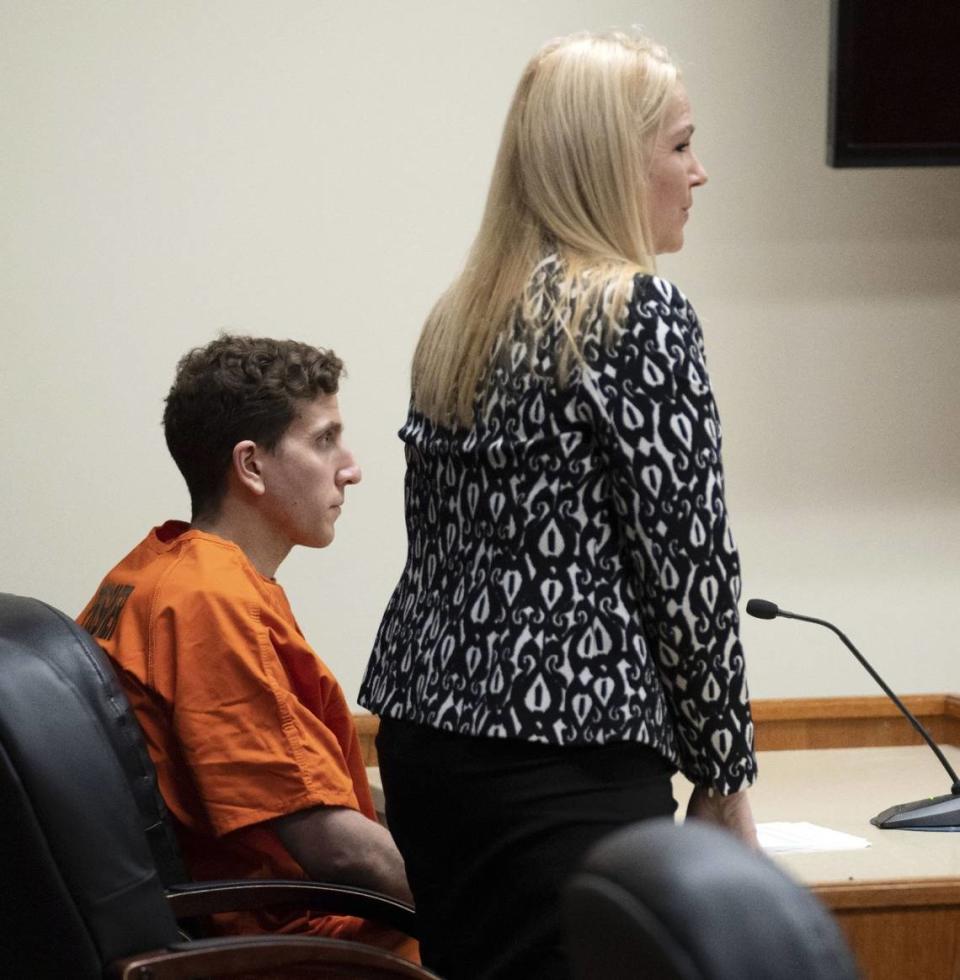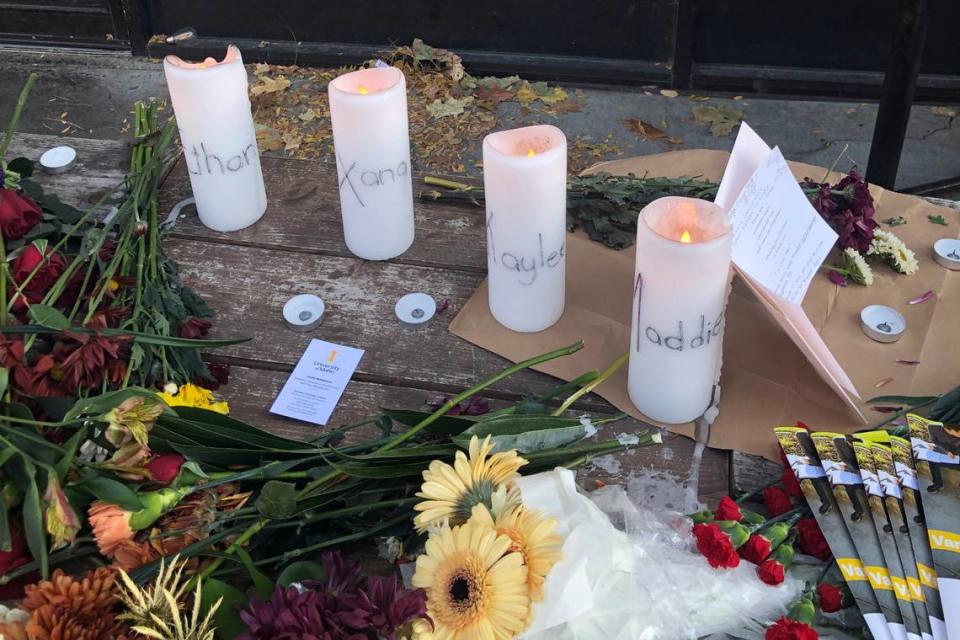Do gag orders like Idaho judge’s in Kohberger case work? Or are they ‘irrelevant’?
Just a week after Bryan Kohberger’s arrest in last year’s killing of four University of Idaho students, Latah County Magistrate Judge Megan Marshall issued a gag order in the case, citing the need for a “balance between protecting the right to fair trial for all parties involved and the right to free expression.”
Not everyone agrees that she struck the right balance in a case that quickly and consistently made headlines across the country.
The family of one of the victims and a coalition of media outlets are fighting the order, saying it restricts their First Amendment rights by being overly broad.
The judge’s order — which was expanded in mid-January, not long after the initial order — prohibits a number of people from speaking publicly about the case, including the attorneys on both sides, investigators, law enforcement personnel and any attorney representing a witness, victim or victim‘s family.
Legal fights aside, there also are questions about whether such orders do what they are intended or are “irrelevant,” as one expert told the Idaho Statesman.
Kohberger is facing four first-degree murder charges in the stabbing deaths of U of I students Madison Mogen, 21, of Coeur d’Alene; Kaylee Goncalves, 21, of Rathdrum; Xana Kernodle, 20, of Post Falls; and Ethan Chapin, 20, of Mount Vernon, Washington. All were killed in an off-campus house in the early morning hours of Nov. 13, 2022.
Kohberger, who could face the death penalty, was arrested at his parents’ house in eastern Pennsylvania on Dec. 30.
What exactly is a gag order and why is one used?
Gag orders are issued by judges, sometimes at the request of attorneys, and they ban those involved in a case from speaking publicly about it. Anyone who violates the order can be held in contempt of court, which carries a penalty of up to $5,000, five days in jail or both in Idaho.
These orders are intended to protect a defendant’s constitutional right to a fair trial by an impartial jury by stopping the spread of information that could prejudice potential jurors.
Kohberger’s attorney, Anne Taylor, chief of the Kootenai County Public Defender’s Office, and Latah County Prosecutor Bill Thompson have supported the gag order.

Not surprisingly, judges generally issue such orders in cases that will attract significant media attention. They have been used when a party involved is widely known by the public — a celebrity, a famous company, a politician or a government entity — or the crime is sensational in nature.
A gag order was in place for Rufo v. Simpson, for example, the civil case brought by the parents of Nicole Brown Simpson and Ronald Goldman against O.J. Simpson, who was accused of killing the pair but found not guilty at a criminal trial. One was also used at Michael Jackson’s criminal trial involving child molestation charges.
Gag orders in Idaho cases are fairly rare. No such order was issued in the ongoing high-profile case against Lori and Chad Daybell, but the judge did opt to move their trials to Ada County from Eastern Idaho because of local pretrial publicity.
A recent high-profile case in which a judge did issue a gag order involved a mass stabbing in Boise. Timmy Kinner Jr. stabbed nine people and killed 3-year-old Ruya Kadir in 2018, and was sentenced to life in prison without the possibility of parole after pleading guilty to murder and eight counts of aggravated battery.
In her order in the Kohberger case, Judge Marshall referenced Sheppard v. Maxwell, a well-known U.S. Supreme Court case that paved the way for the use of court gag orders.
In 1954, prominent Cleveland Dr. Sam Sheppard was charged with stabbing his pregnant wife to death. The case — with an attractive, affluent couple at its center and countless baffling details — garnered widespread national attention. Local media covered the crime feverishly, with much of the coverage insinuating or outright claiming Sheppard was guilty. The prosecutor, police and judge all expressed belief in Shepherd’s guilt to reporters, according to the Free Speech Center. Headlines included “Getting Away With Murder,” “Why No Inquest? Do It Now, Dr. Gerber” and “Quit Stalling — Bring Him In.”
All three Cleveland newspapers published the names and addresses of the 75 potential jurors, resulting in people contacting them with details on the case, according to the Supreme Court opinion.
After the jury found him guilty, Sheppard filed a federal petition. The Supreme Court ruled 8-1 that jurors’ views could have been altered by media coverage, thus violating the doctor’s right to a fair trial. Since the ruling, judges have often cited the case in issuing gag orders in high-profile trials.
Why are some fighting the gag order in U of I case?
A coalition of more than two dozen media outlets, including the Idaho Statesman, filed a motion against the gag order, believing it violates the First Amendment, the Statesman previously reported. The group is led by The Associated Press and also includes The New York Times and The Washington Post.
In the motion, Boise-based attorney Wendy Olson argued that gag orders cannot be “vague, overbroad, unduly restrictive, or not narrowly drawn.” Olson is a former U.S. Attorney for the District of Idaho who is now with the private law firm Stoel Rives.
Courts have previously upheld that gag orders must have narrow parameters to ensure freedom of the press. In Nebraska Press Association v. Stuart, a 1976 U.S. Supreme Court case that sided with the media and limited the reach of gag orders, Chief Justice Warren Burger said it’s in the public’s best interest for the press to have access to information.
“The press does not simply publish information about trials, but guards against the miscarriage of justice by subjecting the police, prosecutors, and judicial processes to extensive public scrutiny and criticism,” Burger wrote in his opinion.
Journalists have often fought gag orders often in high-profile cases, including those initially enacted for the trials of Guantanamo Bay prisoners.
The attorney for the Goncalves family filed a separate challenge to the gag order. Shanon Gray requested that Marshall amend the gag order to remove attorneys for victims’ families from being barred from commenting. Gray argued that he is not a party to the case, and he called the order “unconstitutionally overbroad.” He said his clients have felt restricted from speaking to the media as well.
Orders that affect a wide array of people can cause many to fear speaking to the press at all, said Kevin Goldberg, a First Amendment specialist at the Freedom Forum.3
“Once there’s any element of vagueness … then you start having people questioning whether they can speak,” Goldberg told the Statesman by phone. “They will almost inevitably default to self-censorship, as you’ve seen, and that is the crux of the problem with gag orders. They are well-intentioned and rarely well-executed.”
Citing the gag order, police have refused to answer general questions from the Statesman, such as how many cellphone towers are in the area near where the homicides occurred; the size of the Moscow jail and of Kohberger’s cell; and the nature of the suspect’s meals. In one case a reporter asked for clarification on an apparent mistake in the probable cause affidavit, but was told no one in law enforcement could answer because of the order.
The Moscow Police Department published a press release stating it would no longer communicate with the public or media about Kohberger’s case, and Moscow Mayor Art Bettge told a reporter that he could not answer questions about the overall community healing in Moscow because of the gag order.

Do gag orders work?
Most legal scholars who study pretrial publicity don’t see the orders as effective at maintaining the impartiality of jurors, according to Jon Bruschke, a California State University, Fullerton professor who researches the subject.
Bruschke said many experts view gag orders as “irrelevant” because they believe pretrial publicity “always causes a bias and no remedy can fix it,” he said.
Brushke said he is among a separate group of experts who believe pretrial publicity has a limited effect on the decisions juries make.
“Either conclusion just sort of points to: Gag orders shouldn’t be that broad,” Brushke told the Statesman by phone. “I just don’t think tidbits of information that come out in the media months before the trial materially alter what the jury is likely to do. That’s my conclusion after reading 65 studies.”
Trials such as what Kohberger is expected to face can take months. At that point, Brushke doesn’t think jurors are likely to focus on news articles they read well before the court proceedings began.
“The research is pretty good that juries work really hard to come up with the right decision,” Brushke said.
Even if gag orders stop certain people from speaking, the media don’t stop reporting on a case. And in the age of the internet, it’s not just professional journalists and outlets producing public content. During the 2022 Johnny Depp v. Amber Heard defamation trial, the hashtag #justiceforjohnnydepp received nearly 7 billion views across TikTok and regularly trended on Twitter, The Washington Post reported.
What happens next in Kohberger gag order?
Arguing “extraordinary circumstances,” the media coalition tried to bypass the usual legal steps and went directly to the Idaho Supreme Court in February in an effort to remove the gag order. But on April 24, the Supreme Court unanimously ruled against accepting the case, saying the complaint should first be filed in District Court.
Attorneys for the coalition resubmitted filings May 2 in the 2nd Judicial District Court in Latah County after the high court’s decision, the Statesman reported.
The Latah County judge filed an order Thursday to set a conference hearing for both the Goncalves and media motions against the gag order at 10 a.m. Pacific time on May 22.

